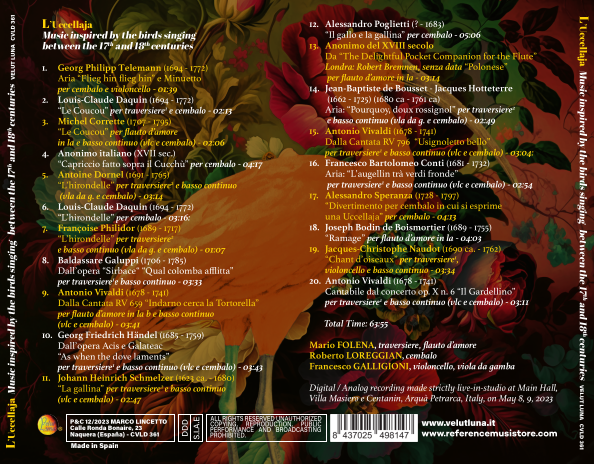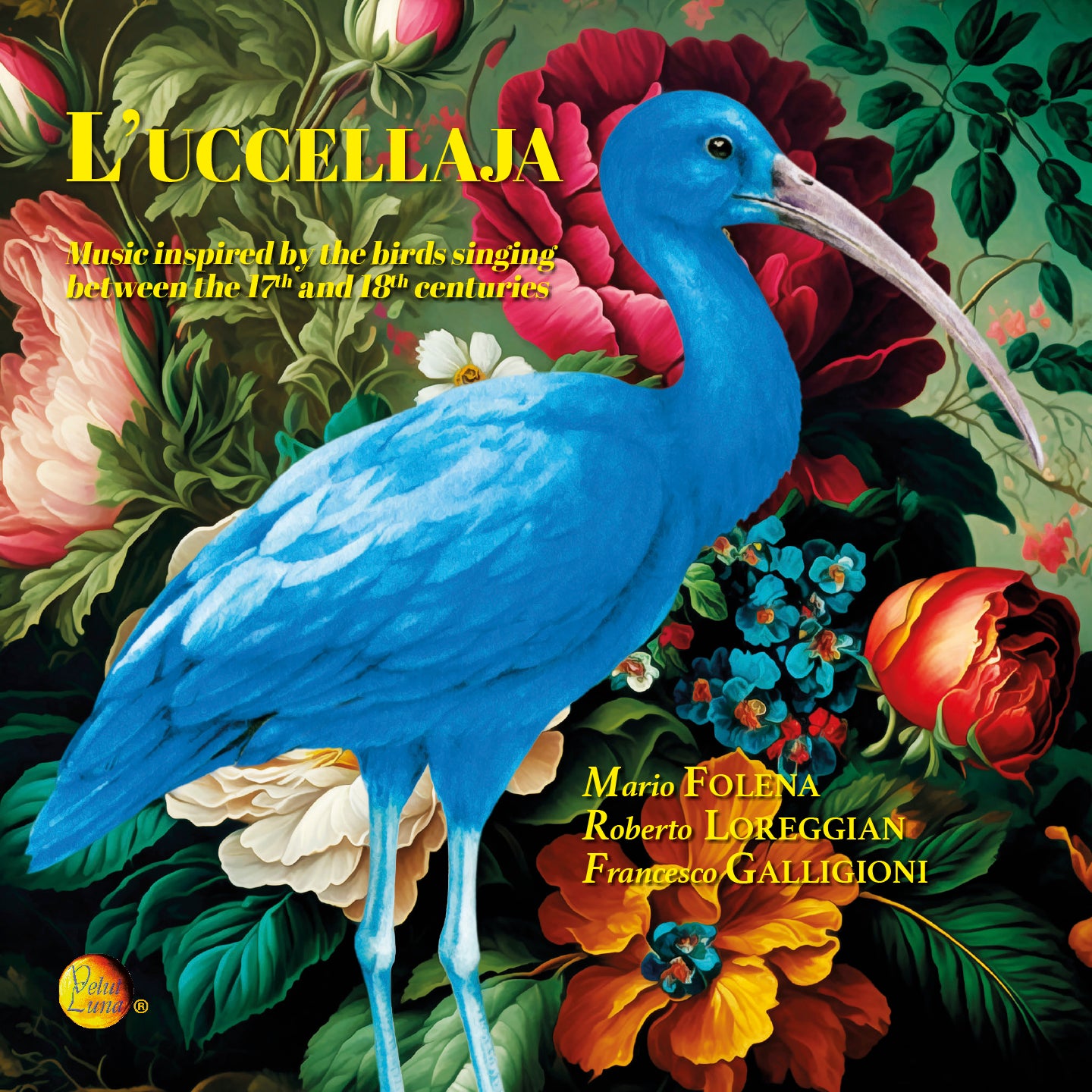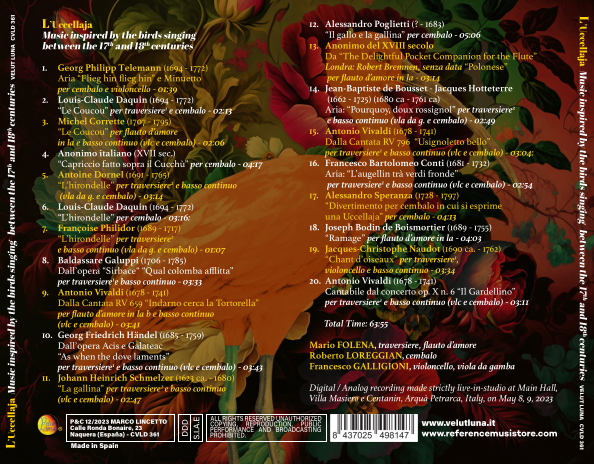Velut Luna
L’UCCELLAJA - Mario FOLENA Roberto LOREGGIAN Francesco GALLIGIONI
L’UCCELLAJA - Mario FOLENA Roberto LOREGGIAN Francesco GALLIGIONI
Genere musicale:
Disponibile
Impossibile caricare la disponibilità di ritiro
L’UCCELLAJA
Music inspired by the birds singing between the 17th and 18th centuries (CVLD361)
Mario FOLENA, traversiere, flauto d’amore
Roberto LOREGGIAN, cembalo
Francesco GALLIGIONI, violoncello, viola da gamba
Disponibile in: File HD, CD
- 1. Georg Philipp Telemann (1694 - 1772)
- 2. Louis-Claude Daquin (1694 - 1772)
- 3. Michel Corrette (1707 - 1795)
- 4. Anonimo italiano (XVII sec.)
- 5. Antoine Dornel (1691 - 1765)
- 6. Louis-Claude Daquin (1694 - 1772)
- 7. Françoise Philidor (1689 - 1717)
- 8. Baldassare Galuppi (1706 - 1785)
- 9. Antonio Vivaldi (1678 - 1741)
- 10. Georg Friedrich Händel (1685 - 1759)
- 11. Johann Heinrich Schmelzer (1623 ca. - 1680)
- 12. Alessandro Poglietti (? - 1683)
- 13. Anonimo del XVIII secolo
- 14. Jean-Baptiste de Bousset - Jacques Hotteterre (1662 - 1725) (1680 ca - 1761 ca)
- 15. Antonio Vivaldi (1678 - 1741)
- 16. Francesco Bartolomeo Conti (1681 - 1732)
- 17. Alessandro Speranza (1728 - 1797)
- 18. Joseph Bodin de Boismortier (1689 - 1755)
- 19. Jacques-Christophe Naudot (1690 ca. - 1762)
- 20. Antonio Vivaldi (1678 - 1741)
Total Time - 63:55
- Traversiere 1 - Martin Wenner, copia da Carlo Palanca
- Traversiere 2 - Federico Xiccato, copia da Chevalier
- Flauto d’amore in la - Federico Xiccato, copia da Dejardin
- Flauto d’amore in la b - Giovanni Tardino, copia da Giuseppe Panormo
- Violoncello - Cremona, fine XVII sec.
- Viola da gamba - Paolo Biordi, Ortimino, 2018 (da Michel Colichon, Paris, 1691)
- Cembalo - Florindo Gazzola, copia da Anonimo italiano del XVII sec.
- Digital / Analog recording made strictly live-in-studio at Main Hall, Villa Masiero e Centanin, Arquà Petrarca, Italy, on May 8, 9, 2023 - Analog Mix and mastering made at VL Studio, Naquera, Spain, on May 11, 12, 2023, using Rupert Neve Design Summing Mixing Console, Maselec MLA-2 / MEA-2 / MPL-2 and Studer A810
- Production: Marco Lincetto and Massimo Corvino Consulting
- Executive producer: Marco Lincettoo
- Musical producer: Marco Lincetto
- Balance, recording, mix and mastering engineer: Marco Lincetto
- Editing: Matteo Costa
- Photo: Musicians’Archive
- Cover Graphics and layout: L’Imag
Celebrare la bellezza e l’ispirazione del canto degli uccelli: è l’obiettivo di questa antologia di composizioni del XVII e XVIII secolo dedicate proprio alle voci delle creature alate. Il cd prende il titolo dal Divertimento per cembalo in cui si esprime una Uccellaja di Alessandro Speranza e include 20 brani - selezionati con cura – d’epoca barocca e rococò.
Il primo pezzo, pagina finora inedita di G. Ph. Telemann, si apre con due note (re - si) che si ripetono enunciando il richiamo del cuculo. Questo incisivo motto musicale, capace di scolpirsi nella nostra memoria uditiva, introduce le successive tracce, dedicate nell’ordine a: cuculo, rondine, tortore e colombe, galli e galline, usignolo, vari uccelli canori
e cardellino.
Tra ‘6 e ‘700 nelle suite strumentali francesi (ma anche in quelle tedesche) era frequente incontrare movimenti con un titolo dallo specifico intento programmatico. Da queste suite (composte da Daquin, Corrette, Philidor, Schmelzer, Boismortier e Naudot) sono tratti i brani dedicati al canto degli uccelli. E al canto degli uccelli si sono ispirati anche molti musicisti italiani, come Poglietti e Speranza: di questi autori e di un Anonimo vengono presentate tre pagine di grande potenza espressiva per cembalo solo.
L’aria di Galuppi Qual colomba afflitta è giunta a noi solamente in veste strumentale. Fa parte di una ponderosa raccolta di arie d’opera, edite a Londra a metà del ‘700 da John Walsh, selezionate e trascritte per traversiere e basso continuo da Carlo Maria Broschi (1705-1782), il famoso castrato detto “il Farinelli”. All’epoca era ancora pratica comune eseguire le composizioni vocali - come arie d’opera o tratte da cantate, le brunettes francesi o le canzoni da battello - in semplice veste strumentale, come avveniva in epoca rinascimentale: una radicata prassi tradizionale con la quale si è pensato di eseguire anche le arie Usignoletto bello di Vivaldi e L’augellin trà verdi fronde di Conti. Il brano di Händel As when the dove laments appartiene invece ad una raccolta di trascrizioni per traversiere e cembalo, edita sempre da J. Walsh a Londra.
Nell’ambito di questa libera forma esecutiva si colloca anche l’aria Porquoy doux rossignol del compositore Jean-Baptiste de Bousset (1662 - 1725), brano molto popolare alla corte del Re Sole. Si tratta di una magnifica aria che Jacques Hotteterre trascrisse per traversiere e basso continuo, contribuendone alla fama e alla diffusione.
The Delightful Pocket Companion for the flute, da cui è tratta la Polonese di autore ignoto qui eseguita sul flauto d’amore, è un vademecum tascabile in più volumetti edito a Londra - senza data - da Robert Bremnen. Al suo interno sono raccolti centinaia di brani originali e trascritti destinati ai numerosi flautisti dilettanti, sempre più avidi di repertorio per il loro strumento. Il tema di questa Polonese, movimento di danza polacca in tre quarti, è il chiocciare della gallina, tanto che con un gioco di parole potrebbe essere rinominata Pollonese.
Il CD si conclude con il celebre Cantabile dal concerto Op. X n. 6 “Il Gardellino” di Antonio Vivaldi, la cui melodia pura e lineare viene in questo cd fiorita, durante i ritornelli, nello stesso spirito capriccioso del brano di Alessandro Speranza: e così, oltre al tipico richiamo arpeggiante del cardellino, si può ascoltare l’imitazione di una miriade di uccelli cinguettanti, tributo alla grandezza della Natura, con un tripudio di note e suoni che ha l’intento di trasportarci in un mondo di emozioni e bellezza.
Mario Folena
Progetto musicale molto ricercato ed originale, esecuzioni impeccabili, registrazione di altissimo livello.
Comprato il file HD ieri notte e ascoltato oggi pomeriggio. Esecuzione stupenda. Sarà anche per il fatto che riprodurre musica da camera in un ambiente domestico è la situazione che più si avvicina all'evento reale (ma proprio per questo è probabilmente la più difficile da risolvere), come ricostruzione della tridimensionalità dell'esecuzione questa è la cosa migliore mai sentita.
Share


-

Spedizioni prodotti fisici
Spedizioni gratuite in Europa (UE), a partire da 4 articoli - Richiedere quatozione per i costi di spedizione per i paesi non UE
-

Consegna prodotti digitali
La consegna dei prodotti digitali avverrà direttamente sul sito e riceverai anche una email con il link per il download dei file.
-

Scrivi una recensione
Qui sopra puoi scrivere una recensione sul prodotto che hai acquistato, saremo felici di conoscere la tua opinione.



